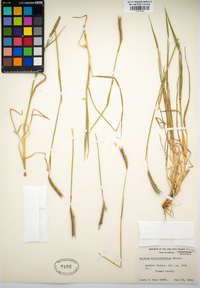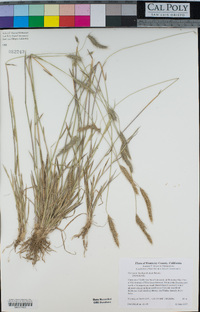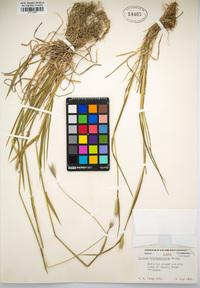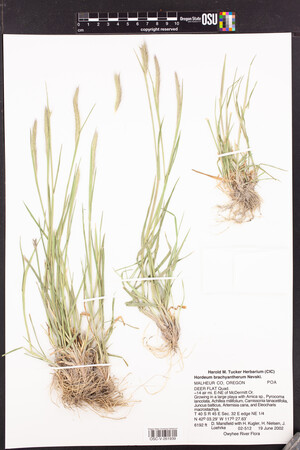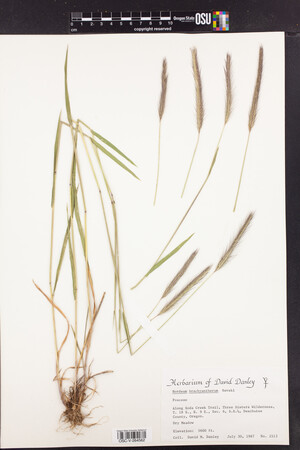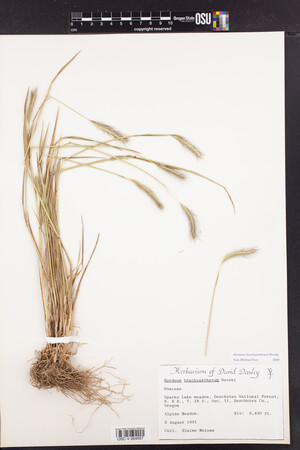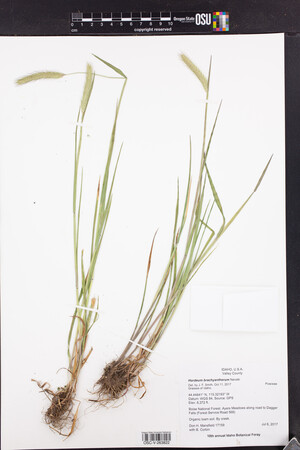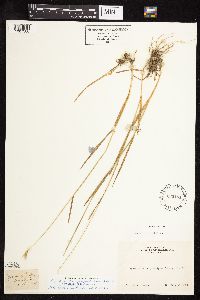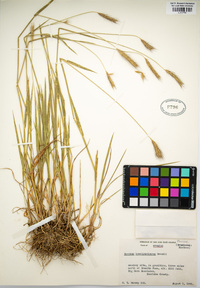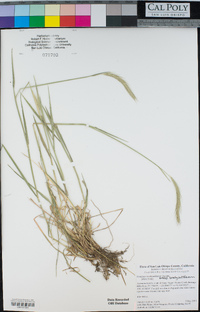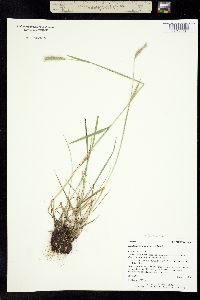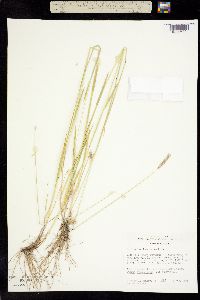Hordeum brachyantherum
|
|
|
|
Family: Poaceae
Meadow Barley
[Hordeum jubatum subsp. brachyantherum] |
Plants perennial; loosely to densely cespitose. Culms to 90 cm, erect to geniculate, not bulbous; nodes glabrous. Sheaths glabrous or densely pubescent; auricles absent; blades to 19 cm long, to 8 mm wide, glabrous or with hairs on both surfaces, hairs sometimes of mixed lengths. Spikes 3-8.5 cm, green to somewhat purple. Glumes 7-19 mm, ascending to slightly divergent at maturity. Central spikelets: glumes 9-19 mm long, about 0.2 mm wide, setaceous throughout, rarely flattened near the base; lemmas 5.5-10 mm, usually glabrous, rarely pubescent, awned, awns 3.5-14 mm; anthers 0.8-4 mm. Lateral spikelets staminate; glumes 7-19 mm, setaceous; lower glumes sometimes flattened near the base; lemmas rudimentary to well developed, awns to 7.5 mm, rarely absent; anthers 0.8-4 mm. 2n = 14, 28, 42. Hordeum brachyantherum is native to the Kamchatka Peninsula and western North America, and has been introduced to a few locations in the eastern United States. There is also a small disjunct population in Newfoundland and Labrador that Baum (1978) identified as H. secalinum. Hordeum brachyantherum grows in salt marshes, pastures, woodlands, subarctic woodland meadows, and subalpine meadows. Two subspecies are recognized here, but there is so much overlap in their morphological variation that unambiguous determination of many specimens is impossible in the absence of a chromosome count. They are sometimes treated as two species. FNA 2007, USDA, Field Guide to Forest & Mtn. Plants of N AZ 2009, Ann. Checklist GCNP 1987 Common Name: meadow barley Duration: Perennial Nativity: Native Lifeform: Graminoid General: Tufted perennial, maximum height up to 1 meter, with a narrow, flattened inflorescence with spikelets in sets of three; inflorescence is purplish in color. Vegetative: Blades to 19 cm long, 8 mm wide, glabrous or hairy on both sides; stems to 90 cm, erect or geniculate, nodes glabrous. Inflorescence: Panicle 5-10 cm long, narrrow, flattened; spikes 3-8 cm long; central spikelets with glumes 9-19 mm long, bristly throughout, lemmas 5-10 mm, usually glabrous, awned, with awns 3-14 mm long, and anthers 1-4 mm long; lateral spikelets staminate, with glumes 7-19 mm long, lemmas with awns to 7 mm, and anthers 1-4 mm; awns break off from the top down upon maturity. Ecology: Found in moist meadows, along streams and lakes, and in clearings from sea level to 13,000 ft. (4000 m); flowers May-August. Distribution: All states west of Texas; also Texas, Mississippi, Missouri, Illinois, Indiana, Ohio, Maryland, Pennsylvania, New Jersey, New York, New Hampshire, and Maine Notes: Its bristly, purple-hued inflorescence distinguishes it from other grass species. Its much shorter glumes and smaller lemma awns distinguish it from H. jubatum. Two subspecies are recognized: Hordeum brachyantherum ssp. brachyantherum, and ssp. californicum. Subspecies brachyantherum has basal sheaths that are usually glabrous and stems that are often robust, versus ssp. californicum, that has basal sheaths that are usually densely pubescent and usually slender stems; also, it is restricted to California. However, there is much morphological variation between the two subspecies that a chromosome count is needed for unambiguous determination. Awns on the spikelets often attach to hair and clothing. Ethnobotany: Used for soil stabilization and sometimes for forage. Etymology: Hordeum is the Latin name for barley,while brachyantherum means short anthers. Editor: LKearsley, 2012 Tufted perennial 3-7 dm, glabrous to scabrous or hairy; lvs flat, 1-5(-7) mm wide, lacking auricles; spikes 2-5(-8) cm (excl. awns), erect, often becoming brownish-purple; central spikelet sessile, the lateral on curved pedicels 0.7-1 mm, their florets much reduced, rarely staminate; glumes awn-like 0.7-2 cm; fertile lemma 6.5-8 mm, faintly 5-veined, tapering into an awn 0.5-1(-2) cm; anthers 1-1.8 mm; 2n=28. Meadows, bottomlands, and salt-marshes; Alas. to Calif., e. to Mont. and N.M., and intr. here and there in our range. Often confused with the European H. nodosum L., with longer awns, longer anthers, and well developed auricles. Gleason, Henry A. & Cronquist, Arthur J. 1991. Manual of vascular plants of northeastern United States and adjacent Canada. lxxv + 910 pp. ©The New York Botanical Garden. All rights reserved. Used by permission. |





